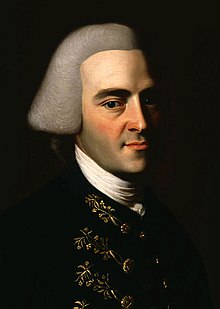John Hancock
| John Hancock | |
|---|---|

Portrait by John Singleton Copley, c. 1770–72
|
|
| 4th President of the Continental Congress | |
|
In office May 24, 1775 – October 31, 1777 |
|
| Preceded by | Peyton Randolph |
| Succeeded by | Henry Laurens |
| 1st and 3rd Governor of Massachusetts | |
|
In office October 25, 1780 – January 29, 1785 |
|
| Lieutenant | Thomas Cushing |
| Preceded by | Office Created (Thomas Gage as colonial governor) |
| Succeeded by | James Bowdoin |
|
In office May 30, 1787 – October 8, 1793 |
|
| Lieutenant | Samuel Adams |
| Preceded by | James Bowdoin |
| Succeeded by | Samuel Adams |
| Personal details | |
| Born |
January 23, 1737 Braintree (now Quincy), Province of Massachusetts Bay |
| Died | October 8, 1793 (aged 56) Hancock Manor, Boston, Massachusetts |
| Resting place | Granary Burying Ground, Boston |
| Spouse(s) | Dorothy Quincy |
| Alma mater | Harvard University (Bachelors) |
| Net worth | US$350,000 at the time of his death (approximately 1/714th of US GNP) |
| Signature | |
John Hancock (January 23, 1737 [O.S. January 12, 1736] – October 8, 1793) was an American merchant, statesman, and prominent Patriot of the American Revolution. He served as president of the Second Continental Congress and was the first and third Governor of the Commonwealth of Massachusetts. He is remembered for his large and stylish signature on the United States Declaration of Independence, so much so that the term "John Hancock" has become, in the United States, a synonym for a signature.
Before the American Revolution, Hancock was one of the wealthiest men in the Thirteen Colonies, having inherited a profitable mercantile business from his uncle. Hancock began his political career in Boston as a protégé of Samuel Adams, an influential local politician, though the two men later became estranged. As tensions between colonists and Great Britain increased in the 1760s, Hancock used his wealth to support the colonial cause. He became very popular in Massachusetts, especially after British officials seized his sloop Liberty in 1768 and charged him with smuggling. Although the charges against Hancock were eventually dropped, he has often been described as a smuggler in historical accounts, but the accuracy of this characterization has been questioned.
Hancock was one of Boston's leaders during the crisis that led to the outbreak of the American Revolutionary War in 1775. He served more than two years in the Continental Congress in Philadelphia, and as president of Congress, was the first to sign the Declaration of Independence. Hancock returned to Massachusetts and was elected governor of the Commonwealth, serving in that role for most of his remaining years. He used his influence to ensure that Massachusetts ratified the United States Constitution in 1788.
...
Wikipedia
